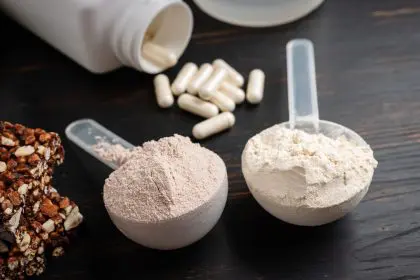The seemingly simple decision between water and milk for your protein shake can significantly influence your fitness journey. While protein powder itself delivers essential amino acids for muscle repair and growth, the liquid you mix it with transforms both its nutritional profile and taste experience. For fitness enthusiasts seeking maximum results from their supplementation routine, understanding the implications of this choice becomes crucial to aligning their shake preparation with specific health and performance goals.
The foundation of effective protein supplementation
Protein shakes have evolved from niche bodybuilding supplements to mainstream nutrition tools. Their popularity stems from convenience and efficiency—delivering high-quality protein in a rapidly digestible format that supports muscle development, weight management, and overall health maintenance. The powder itself typically contains 20-30 grams of protein per serving from sources like whey, casein, egg, or plant proteins (pea, rice, hemp).
However, the nutritional equation changes dramatically depending on your mixing liquid. Water creates a fundamentally different shake than milk, with cascading effects on everything from calorie content to digestibility. This distinction matters particularly for those with specific fitness targets, dietary restrictions, or performance objectives.
1. Caloric content and weight management goals
The most significant difference between water and milk-based protein shakes lies in their caloric content. A typical 30-gram serving of whey protein powder mixed with water contains approximately 120 calories, almost entirely from protein. The same powder mixed with a cup of whole milk jumps to around 250 calories due to milk’s additional protein, fat, and carbohydrates.
For those focused on weight loss or maintaining a caloric deficit, water-based shakes provide protein without additional calories. This approach supports muscle preservation during fat loss phases while minimizing caloric intake. Individuals tracking macronutrients or following specific dietary protocols often prefer water for its neutral nutritional profile that doesn’t require additional calculations.
Conversely, individuals pursuing muscle gain often benefit from milk’s additional calories. During bulking phases or for those struggling to consume enough calories throughout the day, milk provides an easy way to increase energy intake while supporting recovery and growth. Hard-gainers—those who struggle to build mass despite regular training—particularly benefit from milk’s additional nutrition.
2. Protein quantity and amino acid timing
While protein powder delivers most of your shake’s amino acids, milk adds meaningful additional protein content. One cup of cow’s milk contributes approximately 8 grams of high-quality protein to your shake. This increases the shake’s total protein content by roughly 25-40% compared to water-based versions.
The protein in milk contains casein (80%) and whey (20%), creating a beneficial combination for muscle recovery. Whey digests rapidly, providing immediate amino acid availability, while casein forms a gel in the stomach that digests more slowly, releasing amino acids gradually over several hours. This combination may extend the anabolic window—the period when your body most effectively utilizes protein for muscle repair.
For post-workout recovery, this dual-action protein delivery system potentially offers advantages over water-based shakes, which typically contain only fast-digesting protein. Research suggests this combination may enhance protein synthesis and reduce muscle breakdown compared to single-source proteins, particularly before bed or during extended periods without eating.
3. Carbohydrate content and performance considerations
Standard cow’s milk contains approximately 12 grams of carbohydrates per cup in the form of lactose (milk sugar). For many athletes, these carbohydrates provide valuable benefits, particularly after intense training sessions when glycogen replenishment becomes a priority.
The post-workout period represents an optimal window for carbohydrate consumption, as exercise increases muscle sensitivity to insulin, enhancing glycogen storage efficiency. The combination of protein and carbohydrates in milk-based shakes may accelerate recovery by simultaneously addressing protein synthesis and glycogen replenishment needs.
However, those following ketogenic, low-carb, or carbohydrate-cycling approaches may find milk’s carbohydrate content problematic. Water-based shakes allow precise control over carbohydrate intake, making them preferable for these dietary strategies. Additionally, individuals monitoring blood sugar levels or those with insulin sensitivity concerns may prefer avoiding milk’s natural sugars.
4. Fat content and hormone optimization
Whole milk contains approximately 8 grams of fat per cup, including saturated, monounsaturated, and polyunsaturated fats. These fats slow digestion, potentially extending protein absorption and promoting satiety. For individuals with healthy relationships with dietary fat, whole milk can enhance shake satisfaction and staying power.
Some research suggests that the fat content in milk may positively influence hormonal responses, particularly in men. Dietary fat plays a role in testosterone production, and some studies indicate that consuming adequate fat helps maintain optimal hormone levels. While a single shake won’t dramatically alter hormonal profiles, consistent nutritional patterns influence long-term hormonal health.
For those monitoring fat intake or following specific macronutrient distributions, skim milk offers a middle-ground approach—providing milk’s protein and carbohydrate benefits with minimal fat content. Alternatively, water-based shakes with added sources of healthy fats like a tablespoon of nut butter or avocado can create customized nutritional profiles.
5. Digestibility and gastrointestinal comfort
Approximately 68% of the global population experiences some degree of lactose intolerance, limiting their ability to digest milk sugar properly. For these individuals, milk-based protein shakes may cause bloating, gas, cramps, or digestive discomfort—issues that can interfere with training performance and general wellbeing.
Water-based shakes eliminate this concern, making them the preferable option for those with lactose sensitivity. Additionally, some individuals find water-based shakes digest more rapidly, causing less fullness during training sessions. This quality makes water-based options ideal for pre-workout consumption when a light stomach supports optimal performance.
For those who enjoy milk’s benefits but struggle with lactose, several alternatives exist. Lactose-free milk provides identical nutritional benefits without the problematic sugar. Alternatively, plant-based milk substitutes offer varying nutritional profiles that may align with specific dietary preferences or restrictions.
6. Taste, texture, and shake satisfaction
The sensory experience of protein shakes significantly influences compliance and satisfaction. Milk creates a creamy, smooth texture that masks the sometimes chalky or artificial taste of protein powders. This improved palatability can make regular protein consumption more enjoyable and sustainable long-term.
Water-based shakes tend to have a thinner consistency and more pronounced flavor from the protein powder itself. Some individuals prefer this lighter texture, particularly in warm weather or when consuming shakes during training sessions. Modern protein formulations have improved dramatically in mixing quality and flavor, making water-based options increasingly palatable.
For those seeking milk’s textural benefits without its nutritional implications, alternatives exist. Unsweetened almond milk provides creaminess with minimal calories (approximately 30-40 per cup), while still offering improved mouthfeel compared to water. Mixing techniques like blending with ice can also enhance texture without additional calories.
7. Practical considerations and lifestyle compatibility
Beyond nutrition, practical factors influence the water versus milk decision. Water-based shakes offer significant convenience advantages—they don’t require refrigeration, can be prepared anywhere with access to water, and leave shaker bottles less susceptible to spoilage in gym bags.
Milk-based shakes require more planning and consideration. Bringing milk to the gym necessitates proper temperature control, and unwashed shakers containing milk residue quickly develop unpleasant odors. For those preparing shakes at work or immediately after training, water often provides the path of least resistance.
Cost considerations may also factor into this decision. While water is essentially free, milk represents an additional expense. For individuals consuming multiple shakes daily, this cost difference accumulates over time. However, milk’s additional nutritional value may justify this expense for those prioritizing recovery and performance benefits.
Plant-based alternatives offering customized solutions
Plant-based milk alternatives provide customizable options beyond the traditional water-versus-milk dichotomy. Each alternative offers unique nutritional characteristics worth considering:
Soy milk most closely resembles cow’s milk nutritionally, providing approximately 7-8 grams of protein per cup. For plant-based athletes, soy offers the most comparable protein boost to dairy milk, making it ideal for muscle building goals.
Almond milk creates creamy texture with minimal caloric impact (30-40 calories per cup when unsweetened), offering a middle ground between water and milk. However, it contains negligible protein, so it doesn’t enhance the shake’s protein content.
Oat milk provides substantial carbohydrates (approximately 16 grams per cup) and moderate protein (3 grams), making it suitable for post-workout recovery when carbohydrate replenishment is prioritized.
Pea milk offers impressive protein content (approximately 8 grams per cup) with minimal carbohydrates, providing an option for dairy-free individuals seeking additional protein without significant carbohydrate intake.
Selecting the optimal plant alternative depends on your specific nutritional goals, taste preferences, and dietary restrictions. Reading nutritional labels becomes essential, as formulations vary significantly between brands.
Making the decision based on your personal goals
The ultimate choice between water and milk depends on aligning with your primary fitness objectives:
For weight loss or cutting phases: Water-based shakes minimize calories while delivering protein essential for muscle preservation during fat loss.
For muscle building or bulking phases: Milk-based shakes provide additional calories, protein, and nutrients that support tissue growth and recovery.
For maintenance or general health: Either option works effectively, with the decision primarily based on taste preference and digestive compatibility.
For pre-workout nutrition: Water-based shakes digest more quickly and sit lighter in the stomach, potentially enhancing training comfort.
For post-workout recovery: Milk-based shakes offer advantages through combined protein sources and carbohydrates that support multiple recovery processes.
Many experienced athletes strategically vary their approach, using water-based shakes during fat loss phases or before workouts, while choosing milk-based options post-workout or during muscle-building periods. This flexible approach allows customization based on changing goals throughout training cycles.
Ultimately, protein supplementation represents one component of a comprehensive nutrition strategy. Whether mixed with water or milk, protein shakes support fitness goals most effectively when incorporated into a well-designed nutritional plan featuring predominantly whole foods, adequate hydration, and appropriate energy balance for your specific objectives.

















